Pelvikachromis: varieties and tips for content
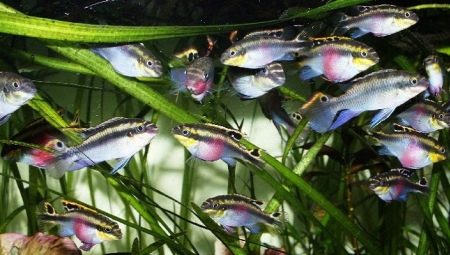
Most of the inhabitants of megalopolises constantly experience stress from the high level of employment and rare communication with wildlife. It is these factors that make the townspeople buy country houses, grow indoor plants and have pets, which help the owners to relax and relieve emotional stress. Psychologists recommend that the busiest people pay attention to aquariums, the maintenance of which will not only require less financial costs, but will also provide an opportunity to show design skills.
All the necessary elements for decorating a home reservoir can be purchased in specialized stores, including fish, the high demand for which has provoked the appearance of a large number of species and subspecies. Some of the most beautiful aquatic inhabitants are pelvicachromis.
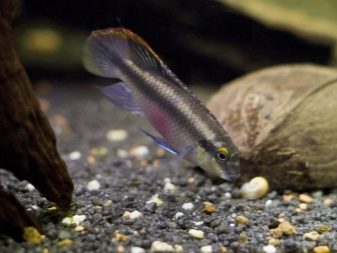
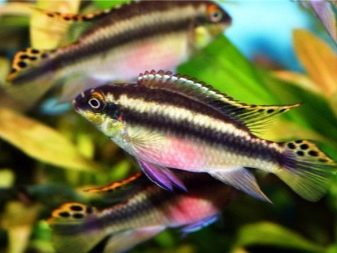
Description
Pelvikachromis pulcher is a beautiful aquarium fish, which belongs to the cichlid family, has a bright appearance and calm disposition. Many aquarists choose this species not only because of its beauty and richness of colors, but also taking into account its unpretentiousness and ease of care. Due to their appearance, the fish are often called parrots or cribensis.
The homeland of this species is the reservoirs of Africa, from where in 1913 the individuals were brought to Germany and began their journey around the world. Cichlids feel most comfortable in stagnant water with a lot of algae.Due to the possibility of obtaining offspring at home, specialists are not engaged in catching pelvicachromis from natural reservoirs, which made it possible to preserve this species and maintain its abundance at a high level. The body size of parrots is relatively small and depends on gender. Males can grow up to 10 cm, and females do not exceed 7 cm. The skeleton of an aquatic inhabitant has an elongated shape and flattened sides. The base color of the body is brownish yellow with black stripes. The color of the abdomen is pale gray with red spots.
A feature of the fish is a gray dorsal fin that runs from head to tail. The shade of the fins on the belly is always red. The tail is shaped like a diamond. Depending on the conditions of keeping and the internal emotional state, the fish changes the intensity and saturation of the color. Distinctive features of males are large size and large fins with dark dots. Females can be recognized by their short fins, full belly and a wide yellow stripe on the dorsal fin. During the spawning period, the belly of the females turns purple-red.
In comfortable conditions of detention and subject to a balanced diet, the cichlid will delight its owners for 5 years.

Overview of varieties
Before you go shopping for aquarium fish of the cichlid family, experts recommend that you carefully study all species, since this family has a species diversity, and the pulcher parrot has the following subspecies.
- Ordinary Is a popular look that has a blue, brilliant or brown-yellow spot on a base gray background. The shade of the abdomen is red-crimson. Feature - the presence of a yellow border and black spots on the tail and dorsal fin.
- Reticulate - a species, the color of which depends on the sex of the fish. In males it is gray-gold, and in females it is red-yellow. The maximum size of this species can reach 10 cm. A distinctive feature is the presence of red spots on the fin.
- Yellow-bellied - a beautiful species, the males of which have dark stripes and red edging on the fins on a beige body, but the females have a crimson tone and a turquoise shade of gills. This species can grow up to 15 cm.
- Cameroon - a parrot, which is colored in a basic purple color and has dark stripes, as well as a turquoise tummy. Distinctive features of the male are purple fins and a yellow-black tail.
- Striped (choppy) - a special look that has 5 color forms. The characteristic difference is a red fin with blue and purple spots.
- Gold-domed - an aristocratic subspecies with a golden head, yellow body and olive fins.
- Roloff Is a light purple species that has brown fins and a white edging on the tail.
- Cribensis Is the most common species that has pointed fins, a base gray color, and a cherry-colored belly.
- Gribentis - a beautiful species, in females of which you can see a pink-purple spot on the belly, and black spots are clearly visible on the caudal and dorsal fin against a yellow background.
- Taeniatus - a very unpretentious species that has an enlarged dorsal and anal fin. Against the background of the general base color, pink fins look spectacular. During the spawning period, the belly of the females becomes a deep pink color.
- Red-cheeked - a rare species that not all aquarists have. The main differences are the presence of a red color in the area of the gills, which smoothly passes to the belly. The color of the back is darker than that of other species.
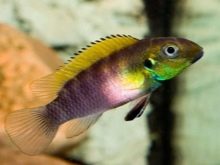
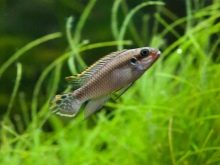

Features of the content
It will not be difficult to create comfortable conditions for the growth and development of fish even for novice aquarists who do not have both professional skills and special equipment.The thermal level of water should be in the range from + 24 to + 27 degrees, the acidity index should not exceed 7.5, and the hardness should not increase more than 10 units.
To calculate the optimal aquarium volume, you need to know the exact number of individuals. For the life of one couple, at least 40 liters of water is needed. To prevent stagnation of the contents of the aquarium, experts recommend changing at least 25% of the water weekly. It is also imperative to install aeration and filtration systems and be sure to purchase a water thermometer and a heater that will help maintain a comfortable temperature range. Aquatic inhabitants have a negative attitude to sharp temperature fluctuations and bright light.
To cover the bottom of the container, it is better to use fine or medium-fraction soil, in which there are no sharp corners. If you put sharp objects in the aquarium, they will certainly provoke mechanical damage to the skin of the fish during their favorite activity - digging holes. List of the most acceptable plants:
- moss;
- riccia;
- duckweed;
- cinema;
- Japanese fern.

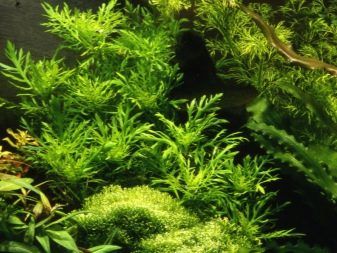
Refugees play a significant role in maintaining a stable emotional state of pets, which serve as shelters for fish when an external threat arises. Diverse driftwood, artificial castles and grottoes, as well as a simple pile of stones will help to make these structures. Beginner hobbyists should pay attention to the following guidelines:
- use of filtration units with a minimum noise level;
- to obtain the same number of males and females, it is necessary to maintain a neutral acidity level in the reservoir;
- the optimal distance of the container from the window is 150 cm;
- mandatory disinfection of all live feed.
Pulvicachromis is not only an unpretentious species, but also an omnivorous, in the diet of which both artificial and natural food can be found. To prevent the development of dangerous diseases, experienced aquarists recommend purchasing only fresh and high-quality mixtures from well-known manufacturers. As a treat, you can use bloodworms, daphnia and brine shrimp. Among herbal supplements, it is better to give preference to spirulina or small slices of fresh cucumber.
Failure to comply with the diet can provoke a significant increase in fish body weight, obesity and dropsy, which will be very problematic to cure.
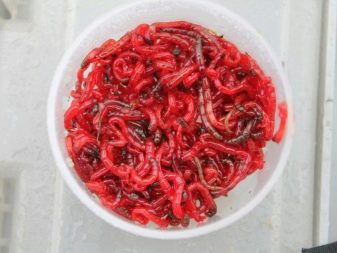
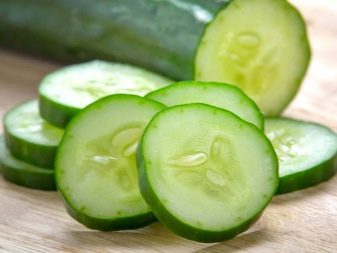
To maximize the balance of the diet, it is necessary to constantly use and alternate different types of feed and not stop at one of them. This nutritional system will have a positive effect not only on the appearance of fish and their color, but also on the functioning of the immune system, which can effectively fight various diseases. Among the most likely fish ailments, experts recommend paying attention to the following pathologies and their symptoms.
- Oodinoz - yellow plaque on the surface of the whole body. Treatment is the use of copper sulfate and special medications.
- Ichthyophthyroidism - white spots and itching.
- Tuberculosis - a change in color, the appearance of fadedness and a decrease in appetite, as well as a slowdown in motor processes.
- Poisoning - lethargy and abdominal distension. The reasons are the excess nitrogen content in the water.
- Hexamitosis - the appearance of holes and mold on the head. The reason is an unbalanced diet and a lack of vitamin C.
- Bulging eyes - edema of the eyeball and its prolapse from the orbit. The reason is non-compliance with water requirements.
During the spawning period, it is necessary to maximize the amount of live products. To prevent the development of putrefactive processes, all food debris must be removed from the reservoir.

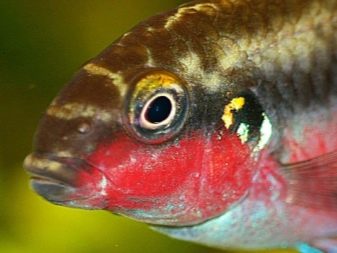
Compatibility with other fish
Despite the fact that the genus of cichlids has a difficult character and difficulties in finding a common language with neighbors, pelvicachromis are an exception.These marine inhabitants have a peaceful and calm disposition and easily find contact with fish, the size of which does not exceed their body length. This feature makes it possible for owners to diversify the aquatic world of their home reservoir as much as possible. The most comfortable neighbors:
- scalars;
- gurus;
- analysis;
- all types of barbs;
- mollies;
- swordtails.
Food for cichlids can be neons, guppies, Denmark, invertebrates, larvae, caviar of other fish, small shrimps and snails. Large predators such as Astronotus, large snail species, piranhas and polypters, which can not only bite the fish, but also eat them, are unwanted company for parrots. During the period of spawning and caring for offspring, this species acquires aggressiveness and belligerence, therefore it can come into conflict with any inhabitant of the reservoir.
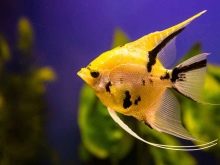
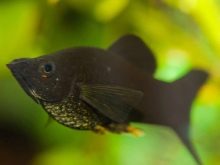
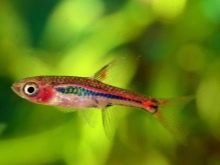
In most cases, parrots do not use algae for food, but their habit of digging the soil can provoke damage to the root system, and subsequently the death of the plant, so it is better to cover the root zone of algae with large roots. Parrots do not have a species predisposition to diseases, but non-observance of sanitary and hygienic standards can provoke a decrease in immunity and the development of dangerous diseases. Among the worst factors, professional aquarists recommend that you pay attention to the following:
- unbalanced diet;
- discrepancy between the volume of the reservoir and the number of living individuals;
- temperature and chemical surges of water;
- excessive lighting;
- constant exposure to noise and loud sound.
If an individual has symptoms of the disease or it has become weak and inactive, experts recommend placing it in a separate reservoir and immediately begin treatment.
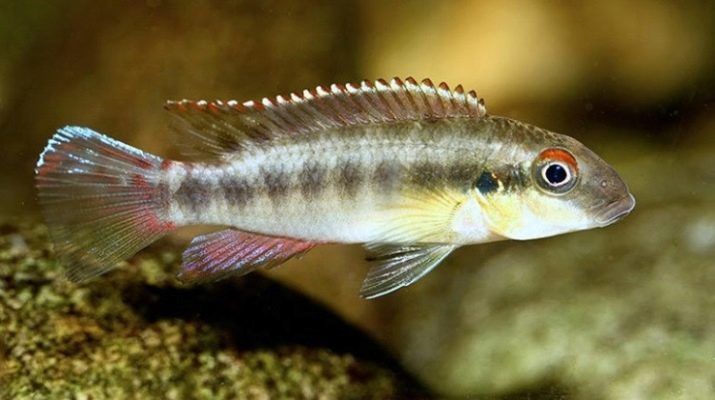
Breeding
To independently obtain offspring, you must have a minimum amount of knowledge and comfortable living conditions for pets, which are best placed in a separate reservoir. Sexual maturity of individuals of this species occurs at the end of the first year of life. The main feature of parrots is the formation of a strong pair, which lasts throughout life. In order to speed up the spawning process, it is necessary to increase the frequency of water changes and increase the amount of live food in the diet. The first signs of spawning are the acquisition of a bright and rich color, as well as the appearance of mating games and aggression towards other inhabitants of the aquarium.
To lay eggs, you must first place a coconut shell or a broken flower pot in a container. Before spawning, the formed pair proceeds to arrange the place for the offspring, from which they remove garbage, soil and other unnecessary things. One female is able to lay from 100 to 300 eggs of red-yellow color, the diameter of which does not exceed 0.2 cm. This species has a very developed parental instinct, it forces the male to guard the shelter with eggs, and the female is constantly next to the offspring.
One of the important features of the reproduction of this species is the possibility of planning the percentage of males and females in the clutch. Scientists have proven that in a more acidic environment, the number of males prevails, but an increased alkaline level contributes to the appearance of females.
5 days after spawning, the eggs begin to crack, and newborn fry appear from them.

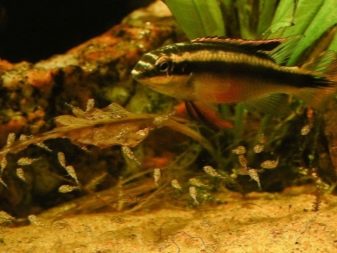
For the final formation and training in swimming, they will need at least 4 more days, and before that they stay near the bottom. The first food for newborns is a crushed boiled egg, live dust and flakes.
To maximize the preservation of offspring, experts recommend a young couple, which is preparing to become parents for the first time, to be removed from eggs. Due to their ignorance and inexperience, young parents can begin to eat their eggs. Even after the kids begin to swim and eat on their own, parents do not lose their vigilance and are constantly next to them.Sometimes they bring them food, and chew large pieces on their own and give them to the children. Two-week-old fish can be fed with brine shrimp and special food for fry.
In the first month of life, babies are covered with dark dots that allow them to hide from predators. Fishes, whose age has exceeded 30 days, acquire all species characteristics and become completely independent individuals.
Fry, 90 days old, can be used for sale as well as for the formation of new bodies of water.
For information on how to properly keep fish of the Pelvicachromis Pulcher species, see the next video.








